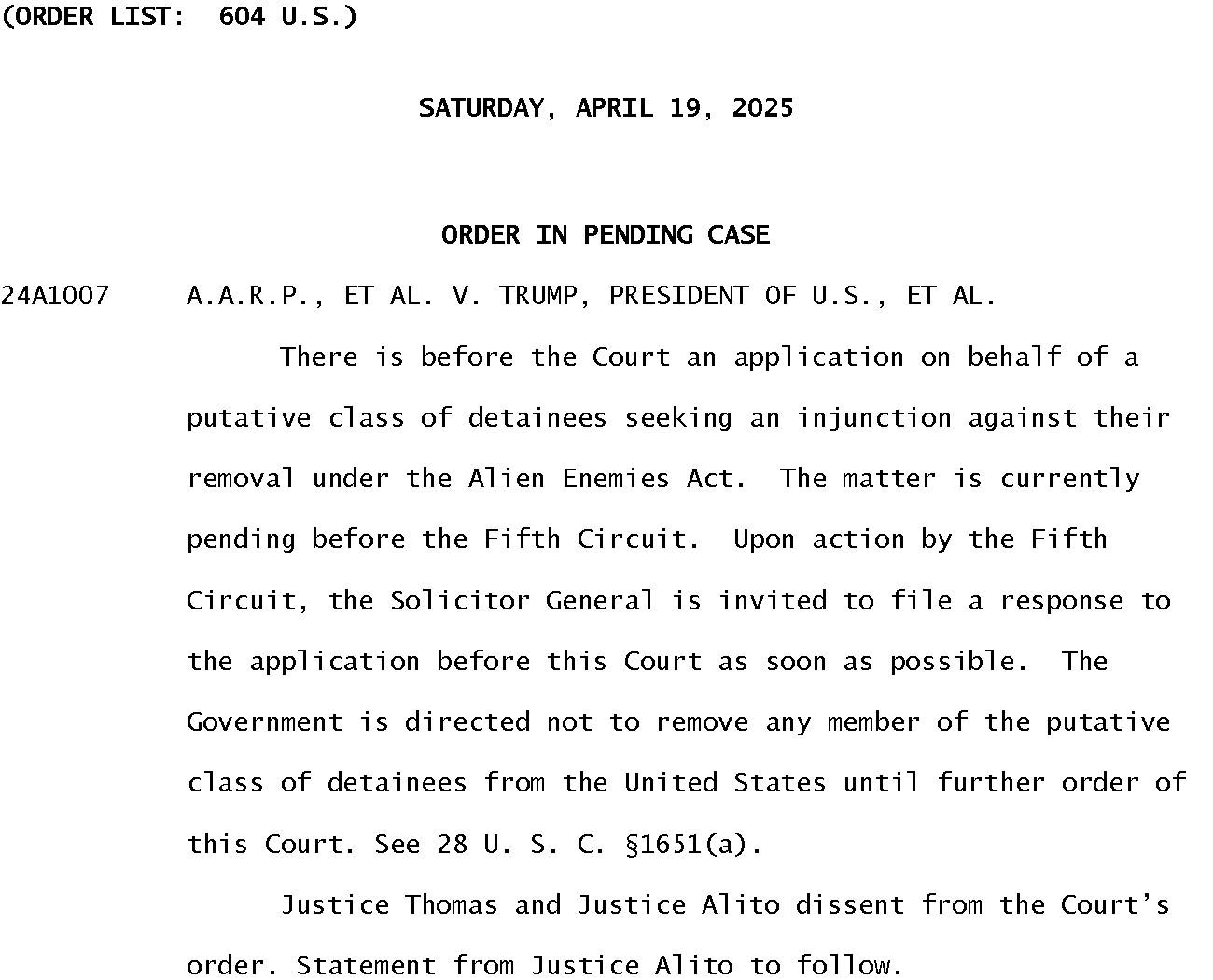Scotus bars removal under the Alien Enemy Act (1789)
by Steve Vladeck (Georgetown Law)
Just before 1:00 a.m. (ET) last night/very early this morning, the Supreme Court handed down a truly remarkable order in the latest litigation challenging the Trump administration’s attempts to use the Alien Enemy Act (AEA) to summarily remove large numbers of non-citizens to third countries, including El Salvador:
I wanted to write a short1 post to try to put the order into at least a little bit of context—and to sketch out just how big a deal I think this (aggressive but tentative) intervention really is.
I. The J.G.G. Ruling
As folks may recall, just 12 days ago, the Court issued a short per curiam opinion in Trump v. J.G.G., in which it held two things: First, a 5-4 majority held that challenges to removal under the AEA must be brought through habeas petitions where detainees are being held, not through Administrative Procedure Act claims in the D.C. district court (like J.G.G.). Second, the Court unanimously held that “AEA detainees must receive notice after the date of this order that they are subject to removal under the Act. The notice must be afforded within a reasonable time and in such a manner as will allow them to actually seek habeas relief in the proper venue before such removal occurs.”
As I wrote at the time, although I disagreed with the majority’s “habeas-only” analysis, the broader ruling made would’ve made at least a modicum of sense if the Court was dealing with any other administration, but it raised at least the possibility that the Trump administration, specifically, would try to play games to make habeas review effectively inadequate. And all of those games would unfold while no court has ruled, one way or the other, on either the facial legal question (does the AEA apply at all to Tren de Aragua); or case-specific factual/legal questions about whether individual detainees really are “members” of TdA. Lo and behold, that’s what happened.
II. The J.A.V. Ruling
In the immediate aftermath of the Court’s April 7 ruling in J.G.G., litigants successfully obtained TROs against AEA removals in three different district courts—the Southern District of New York; the District of Colorado; and, as most relevant here, the Southern District of Texas. In the S.D. Tex. case (J.A.V. v. Trump), Judge Fernando Rodriguez (not that it should matter, but a Trump appointee) barred the government from removing the named plaintiffs or anyone else “that Respondents claim are subject to removal under the [AEA] Proclamation, from the El Valle Detention Center.” (The other rulings were also geographically specific.)
III. The A.A.R.P. Case
Then things got messy. According to media reports, starting on Thursday, a number of non-citizens being held at the Bluebonnet detention facility in Anson, Texas (in the Northern District of Texas) were given notices of their imminent removal under the AEA (in English only), with no guidance as to how they could challenge their removal in advance. Not only did this appear to be in direct contravention of the Supreme Court’s ruling in J.G.G., but it also raised the question of whether the government was moving detainees to Bluebonnet, specifically, to get around the district court orders barring removals of individuals being held at El Valle and other facilities.
The ACLU had already filed a habeas petition on Wednesday in the Northern District of Texas on behalf of two specific (anonymous) plaintiffs and a putative class of all Bluebonnet detainees—captioned A.A.R.P. v. Trump. Judge Hendrix had already denied the ACLU’s initial motion for a TRO—based on government representations that the named plaintiffs were not in imminent threat of removal (he reserved ruling on the request for class-wide relief).
Thus, once the news of the potentially imminent AEA removals started leaking out, the ACLU did two things at once: It sought renewed emergency relief from Judge Hendrix in the A.A.R.P. case, and it went back to Chief Judge Boasberg in the J.G.G. case—which has not yet been dismissed—since that case at least for the moment includes a nationwide class of individuals subject to possible removal under the AEA. And while it waited for both district judges to rule, the ACLU sought emergency relief in A.A.R.P. from both the Fifth Circuit and the Supreme Court.
Sometime after 7 p.m. ET on Friday, Chief Judge Boasberg declined to issue a TRO in J.G.G., concluding from the bench (in my view, correctly) that he couldn’t do so in light of the Supreme Court’s ruling in his case, specifically. Meanwhile, Judge Hendrix issued a brief opinion noting that, although he had been trying to move quickly on the ACLU’s renewed emergency motion, the fact that the ACLU had already gone up to the Fifth Circuit and the Supreme Court deprived him of jurisdiction to do anything further. (I’m not sure that’s true since those were requests for emergency relief, not plenary appeals, but c’est la vie.)

No comments:
Post a Comment